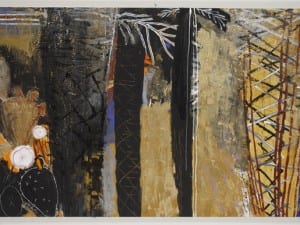Review by Bethany Rex
The Northern Art Prize celebrates and rewards contemporary visual artists based in the North of England. Now in its 4th year, it has established itself as a significant and relevant not only in the North, but nationwide too. A maximum of 24 artists are put forward by 12 nominations from the North East, North West and Yorkshire regions. The lucky four who make the shortlist exhibit their work in a group show at Leeds Art Gallery. We popped over to the Award Ceremony not only to extend our congratulations to Haroon Mirza, this year’s winning artist, but to celebrate the contribution of all those who took part.
The Northern Art Prize is judged by a panel, which this year, included Richard Greer (Collector), Susan Hiller (Artist), Mark Lawson (Journalist, Broadcaster and Author), Tanja Pirsig-Marshall (Curator of Exhibitions, Leeds Art Gallery) and Andrea Rose (Director of Visual Arts, British Council). Unusually, however, there is also an online public vote, which was won by Lubaina Himid. There was no prize for this accolades as such, just the knowledge that those who visited the exhibition (it has been on since 26 November 2010) liked your work the best. This supposed gap between public and professional opinion prompts a host of questions relating to awards in the arts; who are they to decide?
There is definitely something to be said for the conversations that occur when we visit exhibitions and spend time with the work. In the gallery it was more than apparent that the conversations surrounding Himid’s Jelly Mould Pavilions (2009-2010) were the most vibrant- unsurprising given the playful yet thought provoking work on display. The effect of Himid’s work is difficult to describe; featuring beautiful and intricate hand-painting Victorian ceramic jelly moulds and prints, surrounded by miniscule figures going about their daily business (my personal favourite was a Muscle Beach body builder in a string vest), the work manages to be interactive despite the fact that, unfortunately, you can look but not touch. Exploring the historical representations of the people of African Diaspora and highlighting the importance of their cultural contribution to the contemporary landscape, Himid explores the social and political issues surrounding black history and identity. It is important to highlight that despite the aesthetically whimsical work on display, these jelly moulds are a device to encourage debate about enslavement, commerce and the pleasure of dialogue.
The crowd surrounding Mirza’s sculptural assemblages and installations was markedly different. A host of puzzled faces, whispered exchanges and raised eyebrows observed Anthemoessa, a combination of Birds of Pray (2010), SOS (2010) and Adhan (2009). Taken from Greek mythology the title, Anthemoessa, is the island where the Sirens are said to have lived, luring unsuspected sailors to their demise by calling out their beautiful song. Birds of Pray is a portrait of two Sirens in which the song is created through malfunctioning electrical items such as a strip light, radio and turntable. The work installed to include Edward Armitage’s (1812-1902) painting The Siren (1888) that has been removed from the Victorian collection and incorporated into the installation. It spills from the video projection points towards the painting, suggesting the works latent narrative. SOS is a siren in itself. An energy saving light bulb slowly revolving over a transistor radio causing interference that generates a sonic accompaniment to the film, Adhan. Texts accompanying Mirza’s work speak of allusions to the contradictions inherent in the Islamic faith and the exploration between hearing and listening, however, perceiving these meanings was difficult and Mirza’s decision to incorporate Armitage’s work into the installation is perplexing. There is much to be said for comments which question the wider value of Mirza’s artistic practice and I think perhaps, including a piece from a time where concepts of artistic skill were both definable and visible only served to add fuel to the fire?
Wider debate aside, the four shortlisted artists; Alec Finlay, Lubaina Himid, David Jacques and Haroon Mirza reflect the broad practice of artists working across rural and urban locations and the exhibition provides a fascinating glimpse into contemporary art practice which should not be missed.
See the exhibition for yourself at Leeds Art Gallery until 6 February 2011. Let us know what you think?
To read more about Haroon Mirza’s work see the “Beyond the Visual: The New Role of Noise” in the February/March issue of Aesthetica. Out 1 February.
Image: Haroon Mirza, Northern Art Prize exhibition. Credit Simon Warner





